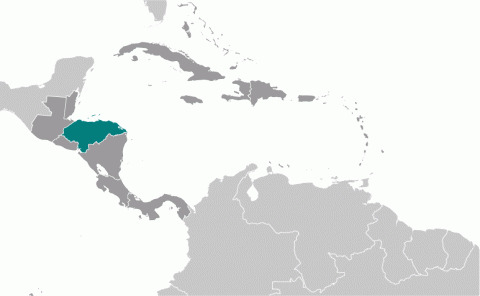Child Labor and Forced Labor Reports
Honduras


Moderate Advancement
In 2024, Honduras made moderate advancement in efforts to eliminate the worst forms of child labor. The government established four new committees, one of which will focus on the prevention of child labor. The government and the Food and Agriculture Organization also held a workshop on child labor and the dangers of pesticide exposure. In addition, the findings from the National Child Labor Survey were presented and published by the Honduran National Institute of Statistics. The results of the survey will be used to inform future policies and programs aimed at the eradication of child labor. However, despite these efforts, labor law enforcement agencies lack the financial and human resources necessary to fulfill their mandates, identifying no child labor violations in 2024. In addition, social programs to address child labor in agriculture are insufficient, and additional social programs are needed to address child labor in mining, domestic work, and illicit gang activity.
| Children | Age | Percent and Population |
|---|---|---|
| Working | 5 to 14 | 19.3% (368,396) |
| Boys | 19.5% | |
| Girls | 18.2% | |
| Urban | 10.2% | |
| Rural | 24.7% | |
| Hazardous Work by Children | 15 to 17 | 13.8% (65,926) |
| Boys | 14.2% | |
| Girls | 13.2% | |
| Urban | 10.0% | |
| Rural | 16.2% | |
| Attending School | 5 to 14 | 93.6% |
| Combining Work and School | 7 to 14 | 15.8% |
| Sector/Industry | Percent of Population |
|---|---|
| Agriculture | 47.2% |
| Industry | 16.2% |
| Services | 36.6% |
| Sector/Industry | Activity |
|---|---|
| Agriculture | Production of melons and coffee. Fishing,† including diving for lobsters.† |
| Industry | Artisanal mining† and construction.† |
| Services | Begging and street vending. Scavenging in garbage dumps.† Domestic work.† |
| Categorical Worst Forms of Child Labor‡ | Forced labor in fishing, mining, construction, and in the hospitality industry. Forced begging, street vending, and domestic work. Commercial sexual exploitation, sometimes as a result of human trafficking. Use in illicit activities, including by gangs in committing extortion, transporting weapons, and selling and trafficking drugs, sometimes as a result of human trafficking. |
† Determined by national law or regulation as hazardous and, as such, relevant to Article 3(d) of ILO C. 182.
‡ Child labor understood as the worst forms of child labor per se under Article 3(a)–(c) of ILO C. 182.
Children at Higher Risk
Reports indicate that girls, returned children, and children in the LGB community are at higher risk of child labor, including its worst forms. In particular, boys from the Miskito Afro-descendant community are vulnerable to forced labor in the agriculture, construction, fishing, mining, and hospitality sectors. The Inter-Institutional Commission to Combat Commercial Sexual Exploitation and the Public Ministry reported cases of commercial sexual exploitation, sometimes perpetrated by family members or friends. Criminal organizations exploit girls in sex trafficking, force children into street begging, and coerce and threaten children to transport weapons, sell drugs, commit extortion, or serve as lookouts.
Barriers to Education Access
There are numerous barriers to education access in Honduras, including poor school infrastructure, gang violence, lack of transportation, and the cost of school fees, uniforms, and supplies. NGO reporting indicates that 40.3 percent of children aged 5 to 17, or 1,156,578 children, are outside the educational system, a number much higher than the official statistics show. Reports also indicate that in some regions of the country, especially La Mosquitia, language barriers exist as the teachers often do not speak local languages. A recent survey conducted by the National Institute for Statistics found that girls were more likely to drop out of school to carry out domestic work. Finally, violence originating from gang activity, including recruitment into gangs and territorial disputes, also presents barriers to access for both children and educators, causing some schools to drastically reduce their enrollment.
| Standard | Age | Meets International Standards | Legislation |
|---|---|---|---|
| Minimum Age for Work | 18 | ✓ | Article 120 of the Code on Childhood and Adolescence; Article 15 of the Executive Agreement STSS-211-01; Article 32 of the Labor Code. |
| Minimum Age for Hazardous Work | 18 | ✓ | Articles 1 and 122 of the Code on Childhood and Adolescence; Articles 2 and 10 of the Executive Agreement STSS‑211-01; Article 1 of the Executive Agreement STSS-441-2016. |
| Identification of Hazardous Occupations or Activities Prohibited for Children | ✓ | Article 1 of the Executive Agreement STSS-441-2016; Article 8 of the Executive Agreement STSS‑211-01. | |
| Prohibition of Slavery, Debt Bondage, and Forced Labor | ✓ | Articles 2 and 10 of the Executive Agreement STSS‑211-01; Articles 6 and 52 of the Law on the Prevention of Human Trafficking (No. 59-2012); Articles 219-222 of the Penal Code. | |
| Prohibition of Child Trafficking | ✓ | Articles 2 and 10 of the Executive Agreement STSS‑211-01; Article 8 of the Legislative Decree 35-2013; Articles 219 and 220 of the Penal Code. | |
| Prohibition of Commercial Sexual Exploitation of Children | ✓ | Article 134 of the Code on Childhood and Adolescence; Articles 2 and 10 of the Executive Agreement STSS‑211-01; Articles 219, 220, 257, and 259–262 of the Penal Code. | |
| Prohibition of Using Children in Illicit Activities | ✓ | Article 134 of the Code on Childhood and Adolescence; Article 10 of the Executive Agreement STSS‑211-01; Articles 6 and 52 of the Law Against Trafficking in Persons (Decree 59-2012); Article 8 of the Legislative Decree 35-2013. | |
| Minimum Age for Voluntary State Military Recruitment | 18 | ✓ | Articles 2 and 12 of the Executive Agreement STSS‑211-01; Article 276 of the Constitution. |
| Prohibition of Compulsory Recruitment of Children by (State) Military | ✓* | Article 276 of the Constitution. | |
| Prohibition of Military Recruitment by Non-state Armed Groups | ✓ | Articles 2 and 10 of the Executive Agreement STSS‑211-01. | |
| Compulsory Education Age | 17 | ✓ | Articles 8, 13, and 21–23 of the Fundamental Law of Education; Articles 36 and 39 of the Code on Childhood and Adolescence. |
| Free Public Education | ✓ | Articles 7, 13, and 21–23 of the Fundamental Law of Education; Article 36 of the Code on Childhood and Adolescence; Article 171 of the Constitution. |
* The law allows for conscription during times of international war, but only for citizens between 18 and 30.
Children in Honduras are required to attend school only up to age 17 even though the minimum age for work is 18. This standard makes children aged 17 vulnerable to child labor as they are not required to attend school but are not legally permitted to work.
| Organization/Agency | Role & Activities |
|---|
| Ministry of Labor and Social Security (SETRASS): Conducts labor inspections and enforces child labor laws through the General Directorate of Social Welfare and the General Directorate of Labor Inspections. |
| Public Ministry: Carries out criminal investigations and prosecutions, including for crimes related to the worst forms of child labor. Through its Office of the Special Prosecutor for Children, prosecutes crimes involving child victims. Also coordinates with the National Police to investigate crimes related to the worst forms of child labor through its Police Investigation Directorate. The Public Ministry, through its Technical Agency for Criminal Investigations, investigates and provides technical support for criminal prosecutions, including by the Office of the Special Prosecutor for Children, such as those related to human trafficking, commercial sexual exploitation, and child pornography. Through its Unit Against Trafficking in Persons, Commercial Sexual Exploitation and Illicit Human Smuggling, coordinates with domestic and international enforcement agencies to carry out anti-trafficking in persons operations and prosecutions. |
| Overview of Enforcement Efforts | 2024 |
|---|---|
| Has a Labor Inspectorate | Yes |
| Able to Assess Civil Penalties | Yes |
| Routinely Conducted Worksite Inspections | Yes |
| Unannounced Inspections Permitted | Yes |
| Has a Complaint Mechanism | Yes |
| Imposed Penalties for Child Labor Violations | No |
| Conducted Criminal Investigations for Worst Forms of Child Labor Crimes | Unknown |
| Imposed Penalties for Worst Forms of Child Labor Crimes | Yes |
In 2024, 141 labor inspectors conducted 391 worksite inspections finding 0 child labor violations. It is unknown whether investigations into the worst forms of child labor were conducted or whether prosecutions were initiated, although 2 perpetrators were convicted.
| Coordinating Body | Role & Activities |
|---|
| National Commission for the Gradual and Progressive Eradication of Child Labor (CONETI): Coordinates government policies and efforts on child labor issues. Chaired by SETRASS and includes officials from eight government ministries; the Secretariat for Children, Adolescence, and Family (SENAF); the Supreme Court; and other government entities. Oversees regional sub-commissions, led by officials from SETRASS and SENAF, which implement efforts at the local level. During the reporting period, CONETI convened with government officials, civil society organizations, and the ILO to discuss the importance of inter-institutional coordination and to discuss the findings of the child labor survey. |
| Policy | Description & Activities |
|---|
| National Plan for the Elimination of Child Labor (2023–2026): Highlights the need to identify risk factors for vulnerability to child labor, establish a common protocol for responding to child labor situations, and conduct awareness-raising on child labor laws and labor rights. Research was unable to determine if activities were carried out to implement this policy during the reporting period. |
| U.S.–Honduras Labor Rights Monitoring and Action Plan (MAP): Aims to improve the enforcement of labor laws, including laws related to child labor, by implementing legal and policy reforms, strengthening SETRASS, and increasing outreach efforts. However, since September 2023, the Government of Honduras has ceased organizing tripartite meetings under this plan. With the tripartite commission being inactive, and the lag in backfilling inspectors since the 2022 mass firing, U.S. and Honduran observers have raised concerns regarding the Honduran government’s commitment to MAP. In 2024, the government continued the development of an electronic case management system to improve enforcement of labor laws. |
| Program | Description & Activities |
|---|
| Solidarity Network (Red Solidaria):‡ Secretariat of Development and Social Inclusion program that consists of a conditional cash transfer of $163 annually to 350,000 families in some of the poorest towns in the country, provided that families vaccinate their children and keep them enrolled in school. The program also includes $32.4 million in investments in health, education, preventing teenage pregnancy, infrastructure, and housing projects. In 2024, the Solidarity Network carried out its "Youth Project," which provided educational centers with new tablets, desks, and additional classrooms. |
| Program to Combat Child Forced Begging:‡ SENAF program that identifies and rescues children who are subjected to forced begging and raises awareness of child forced begging through media. Despite being active during the reporting period, research was unable to determine if activities were carried out to implement this program. |
| Program for the Reintegration of Returned Children:‡ The program protects and assists unaccompanied children who have been returned to Honduras. Implemented by SENAF in collaboration with the National Institute for Migration, the Ministry of Foreign Affairs, UNICEF, the Network of Institutions for Children’s Rights, the International Organization for Migration (IOM), and NGO Aldeas SOS. UNICEF, through IOM, provides financial support for the program. Children are received at reception centers in Omoa, La Lima, and Belen, but the Belen Center is the only center that supports unaccompanied children and their families. It offers reintegration services and lodging with capacity for 110 people. In addition, the three centers provide the following services: immigration registration, psychological care, primary medical care, Restoring Family Links by phone and internet, and protection services. During the reporting period, the Belén center received and supported 7,297 children. |
† Program is funded by the Government of Honduras.
‡ The government had other social programs that may have included the goal of eliminating or preventing child labor.
| Area | Suggested Action |
|---|---|
| Legal Framework | Raise the compulsory education age from 17 to 18 to align with the minimum age for work. |
| Enforcement | Conduct sufficient labor inspections in areas in which child labor is prevalent, such as rural areas and the informal sector, in which children engage in hazardous activities. |
| Provide information related to the number of child labor violations for which penalties were imposed and collected. | |
| Ensure labor law enforcement agencies have sufficient funding to carry out their mandates nationwide and increase the number of labor inspectors from 141 to 262 to ensure adequate coverage of the labor force of approximately 3.9 million workers. | |
| Ensure criminal law enforcement agencies have sufficient funding to carry out their mandates nationwide. | |
| Properly classify the worst forms of child labor crimes, thoroughly investigate the crimes, and prosecute offenders. Publish criminal law enforcement information, including the number of investigations conducted and prosecutions initiated. | |
| Ensure enforcement authorities utilize the established referral mechanism to provide the families of children removed from child labor, particularly the worst forms, with social protection services such as conditional cash transfers for families in poverty, health and nutrition programs, and education programs. | |
| Ensure that the number of inspections conducted by labor inspectors is commensurate with the size of the labor inspectorate to ensure the adequate quality and scope of inspections. | |
| Improve interagency coordination for criminal investigators and conduct additional trainings on the worst forms of child labor. | |
| Government Policies | Ensure that activities are undertaken to implement the National Plan for the Elimination of Child Labor (2023–2026) and publish results from activities implemented on an annual basis. |
| Social Programs | Expand access to education by increasing funding and infrastructure for schools, enhancing efforts to protect students from gang violence, and ensuring that all students are able to attend school with sufficient support, including children with disabilities and those in rural areas. |
| Ensure that social programs reach the children who are most vulnerable to child labor, including children of African descent and native children. | |
| Expand social programs that address child labor in agriculture and create programs to assist children engaged in child labor in fishing, mining, domestic work, and illicit gang activity. | |
| Improve oversight of children's shelters and increase protection measures to prevent human trafficking and forced labor of children living in the shelters. | |
| Report on specific activities carried out to implement the Program to Combat Child Forced Begging on an annual basis. |




